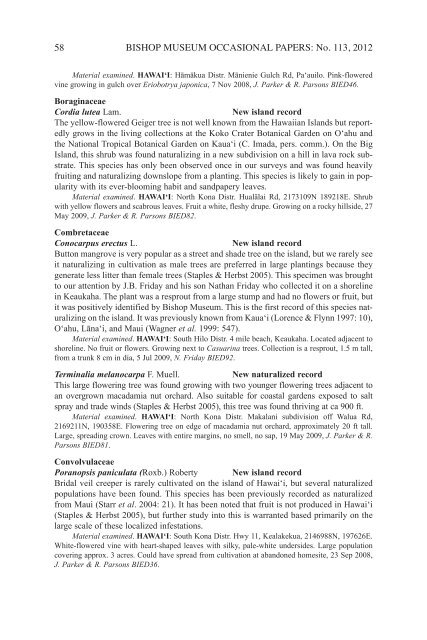OCCASIONAL PAPERS - Hawaii Biological Survey - Bishop Museum
OCCASIONAL PAPERS - Hawaii Biological Survey - Bishop Museum
OCCASIONAL PAPERS - Hawaii Biological Survey - Bishop Museum
Create successful ePaper yourself
Turn your PDF publications into a flip-book with our unique Google optimized e-Paper software.
58<br />
BISHOP MUSEUM <strong>OCCASIONAL</strong> <strong>PAPERS</strong>: No. 113, 2012<br />
Material examined. HAWAI‘I: Hāmākua distr. Mānienie Gulch rd, Pa‘auilo. Pink-flowered<br />
vine growing in gulch over Eriobotrya japonica, 7 Nov 2008, J. Parker & R. Parsons BIED46.<br />
Boraginaceae<br />
Cordia lutea lam. New island record<br />
The yellow-flowered Geiger tree is not well known from the <strong>Hawaii</strong>an Islands but reportedly<br />
grows in the living collections at the Koko crater Botanical Garden on o‘ahu and<br />
the National Tropical Botanical Garden on Kaua‘i (c. Imada, pers. comm.). on the Big<br />
Island, this shrub was found naturalizing in a new subdivision on a hill in lava rock substrate.<br />
This species has only been observed once in our surveys and was found heavily<br />
fruiting and naturalizing downslope from a planting. This species is likely to gain in popularity<br />
with its ever-blooming habit and sandpapery leaves.<br />
Material examined. HAWAI‘I: North Kona distr. Hualālai rd, 2173109N 189218E. Shrub<br />
with yellow flowers and scabrous leaves. fruit a white, fleshy drupe. Growing on a rocky hillside, 27<br />
May 2009, J. Parker & R. Parsons BIED82.<br />
Combretaceae<br />
Conocarpus erectus l. New island record<br />
Button mangrove is very popular as a street and shade tree on the island, but we rarely see<br />
it naturalizing in cultivation as male trees are preferred in large plantings because they<br />
generate less litter than female trees (Staples & Herbst 2005). This specimen was brought<br />
to our attention by J.B. friday and his son Nathan friday who collected it on a shoreline<br />
in Keaukaha. The plant was a resprout from a large stump and had no flowers or fruit, but<br />
it was positively identified by <strong>Bishop</strong> <strong>Museum</strong>. This is the first record of this species naturalizing<br />
on the island. It was previously known from Kaua‘i (lorence & flynn 1997: 10),<br />
o‘ahu, lāna‘i, and Maui (Wagner et al. 1999: 547).<br />
Material examined. HAWAI‘I: South Hilo distr. 4 mile beach, Keaukaha. located adjacent to<br />
shoreline. No fruit or flowers. Growing next to Casuarina trees. collection is a resprout, 1.5 m tall,<br />
from a trunk 8 cm in dia, 5 Jul 2009, N. Friday BIED92.<br />
Terminalia melanocarpa f. Muell. New naturalized record<br />
This large flowering tree was found growing with two younger flowering trees adjacent to<br />
an overgrown macadamia nut orchard. also suitable for coastal gardens exposed to salt<br />
spray and trade winds (Staples & Herbst 2005), this tree was found thriving at ca 900 ft.<br />
Material examined. HAWAI‘I: North Kona distr. Makalani subdivision off Walua rd,<br />
2169211N, 190358E. flowering tree on edge of macadamia nut orchard, approximately 20 ft tall.<br />
large, spreading crown. leaves with entire margins, no smell, no sap, 19 May 2009, J. Parker & R.<br />
Parsons BIED81.<br />
Convolvulaceae<br />
Poranopsis paniculata (roxb.) roberty New island record<br />
Bridal veil creeper is rarely cultivated on the island of Hawai‘i, but several naturalized<br />
populations have been found. This species has been previously recorded as naturalized<br />
from Maui (Starr et al. 2004: 21). It has been noted that fruit is not produced in Hawai‘i<br />
(Staples & Herbst 2005), but further study into this is warranted based primarily on the<br />
large scale of these localized infestations.<br />
Material examined. HAWAI‘I: South Kona distr. Hwy 11, Kealakekua, 2146988N, 197626E.<br />
White-flowered vine with heart-shaped leaves with silky, pale-white undersides. large population<br />
covering approx. 3 acres. could have spread from cultivation at abandoned homesite, 23 Sep 2008,<br />
J. Parker & R. Parsons BIED36.

















